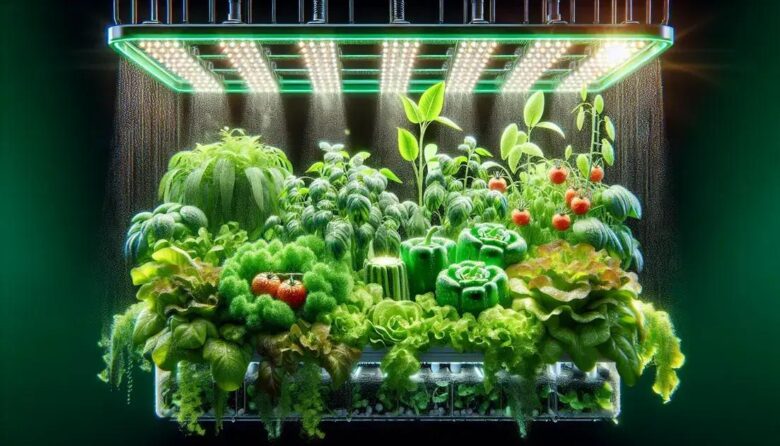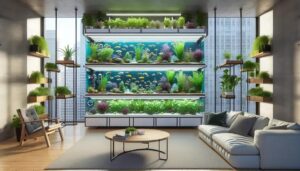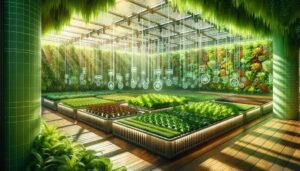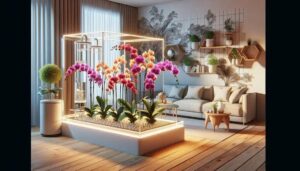LED lighting in hydroponics offers customizable spectrums, enhancing plant growth through energy-efficient, low-heat outputs beneficial for various growth stages, making it essential for modern, sustainable agricultural practices.
Ever wondered how to supercharge your hydroponic setup? Enter the world of LED lighting and its fascinating role in vegetable growth. LEDs don’t just light up your plants; they hold the key to unlocking new levels of productivity. Curious to dive deeper into this innovative approach?
understanding LED spectrum and its importance
In the world of hydroponics, understanding the LED spectrum is crucial for optimizing plant growth. LED lights offer a range of spectral outputs that mimic natural sunlight, providing specific wavelengths essential for photosynthesis. Different colors in the LED spectrum, from blue to red, influence various growth stages of plants. Blue light promotes vegetative growth, while red light is vital for flowering and fruit production. These lights can be customized to suit different plant needs, making them an invaluable tool in hydroponics.
Moreover, LED lights are energy-efficient, reducing the overall operational costs in a hydroponic system. The precise control over the light spectrum allows growers to experiment and identify the most effective spectral combinations for their crops. As a result, LED lighting not only assists in maximizing yield but also enhances the quality of the produce.
Why is LED spectrum important?
Using the correct LED spectrum can drastically improve the growth rate and health of hydroponic vegetables. Plants mainly rely on light for energy, and the right spectrum ensures optimal metabolic processes. Especially in indoor or climate-controlled environments, the right LED spectrum compensates for the lack of natural sunlight, ensuring plants get the best conditions possible for growth without weather-related interruptions. This makes understanding the LED spectrum not just important, but essential for any successful hydroponic farming endeavor.
Exploring different LED spectrums
Blue and red LEDs are commonly used; however, advancements have introduced full-spectrum LEDs that cater to all growth stages. This adaptability allows growers to fine-tune light recipes for specific crops and growth phases, providing a tailor-made lighting solution for optimal plant cultivation.
how LED lighting affects hydroponic vegetables
The impact of LED lighting on hydroponic vegetables is profound and transformative. Unlike traditional lighting, LEDs provide a controllable spectrum that caters to the needs of plants at different growth stages. This ensures each plant receives the optimal light for photosynthesis, leading to healthier and more robust growth.
LEDs are highly energy-efficient, reducing costs for indoor farming operations. They generate less heat compared to high-intensity discharge lights, allowing growers to place them closer to plants without risk of heat damage. This proximity maximizes light absorption, enhancing the efficiency of photosynthesis processes.
Using LED lights also means you can extend the growing season, producing crops year-round regardless of external weather conditions. This control over the growing environment ensures a consistent supply of fresh produce. Additionally, the adjustable spectrum options allow for customization to suit specific plant requirements, promoting faster growth cycles and potentially higher yields.
Boosting Growth and Yield
The right LED lighting setup can boost the nutrient uptake efficiency of plants. By providing the ideal spectrum during critical growth phases, LEDs support increased plant vigor and resilience. This results in not only higher yields but also improved quality of the fruits and vegetables produced.
choosing the right LED spectrum for different plants
Choosing the right LED spectrum for different plants is essential for optimizing growth and development. Each plant species has unique light requirements, and tailoring the LED spectrum to meet these needs can significantly enhance growth efficiency. For example, leafy greens like lettuce thrive under a specific mix of blue and red light, whereas fruiting plants like tomatoes might need more intense red light during the flowering and fruiting stages.
Understanding the specific growth stages of your plants helps you customize the light spectrum accordingly. During the vegetative stage, plants often benefit from a higher ratio of blue light to encourage strong, leafy growth. As plants transition to the flowering stage, increasing red light input supports blooming and fruit production.
Utilizing Full-Spectrum LEDs
Full-spectrum LEDs are versatile and can simulate natural sunlight, covering a broad range of wavelengths. These lights are ideal for growers with diverse plant species in a single grow area, as they provide balanced light exposure for all. This ensures that every plant receives the right light for each growth phase without constant adjustments.
It’s important to monitor plant responses to light and make necessary adjustments. Investing in adjustable-spectrum LED systems can provide flexibility, allowing you to fine-tune lighting setups to suit specific plant demands over time. This ensures that your hydroponic system remains adaptable to changes in plant growth conditions.
ways to optimize hydroponic setups with LEDs
Optimizing hydroponic setups with LEDs involves several strategies aimed at enhancing plant growth and reducing costs. One effective method is arranging LED lights at optimal distances to ensure even light distribution across all plants. This prevents shading and guarantees that all plants receive adequate light.
Using reflective materials on the walls of your grow area can also improve light efficiency. These materials help redirect the light to reach under-canopy areas, maximizing the benefits of LED lighting. Additionally, employing a timer system allows for precise control of the light cycle, matching the specific needs of different plant species.
Energy Efficiency and Cost Reduction
Selecting energy-efficient LED lights reduces electricity costs significantly. These lights have a longer lifespan than traditional options, resulting in lower maintenance and replacement expenses. Monitoring and adjusting the light spectrum based on plant needs ensures that energy consumption aligns closely with growth requirements, preventing waste.
To further optimize, consider integrating smart technology to automate lighting schedules and monitor system performance. Smart systems can adjust light intensity and spectrum in real time, providing ideal conditions for plant growth while conserving energy. This level of control helps reduce costs and enhances productivity in hydroponic setups.
case studies of successful hydroponic farms using LEDs
Examining case studies of successful hydroponic farms utilizing LED technology provides valuable insights into effective strategies. One standout example is a farm in the Netherlands that leverages a controlled LED light spectrum to enhance the growth of leafy greens. By fine-tuning the red and blue light ratios, they achieved a significant increase in yield and reduced growth time.
Another impressive case is in California, where a vertical farm uses full-spectrum LEDs to cultivate strawberries year-round. The use of these advanced lights enabled precise control over the growing environment, leading to a consistent and high-quality crop, regardless of external weather conditions. This operation has successfully minimized energy consumption while maximizing fruit production.
Impactful Implementations
In Japan, a hydroponic farm combined smart technology with LED systems to grow various vegetables. Their application of smart sensors and adjustable-spectrum LED lights allowed real-time adjustments to optimize plant health, demonstrating technological synergy’s power in agriculture. This approach not only boosted efficiency but also produced more resilient crops.
These case studies underscore the versatility and effectiveness of LEDs in hydroponics. By applying similar techniques, growers worldwide can adapt these strategies to enhance productivity and sustainability in their operations.
future trends and innovations in LED technology for hydroponics
The future of LED technology in hydroponics is promising, with innovators constantly pushing the boundaries. Emerging trends include the development of even more energy-efficient LEDs that reduce power consumption while enhancing light output. These advancements mean that growers can achieve greater yields with lower costs, increasing overall sustainability.
Another exciting innovation is the integration of smart technology with LED systems. This includes automatic adjustments to light spectrums based on plant needs, using sensors and data analytics. Such systems enhance precision in light management, promoting optimal growth conditions for all plant types in real-time.
Advancements in Spectrum Customization
Future LED technologies are also focusing on hyper-customizable spectrums that allow growers to tailor light settings to specific plants’ requirements down to the smallest detail. This personalization can significantly improve growth rates, plant health, and yield quality.
Another trend to watch is the use of UV and far-red light in LEDs, encouraging more robust plant characteristics and novel growth responses. As research in plant photobiology expands, so too will the applications of these advanced spectrums in practical farming.
The future of LED technology in hydroponics
LED technology is revolutionizing the way we grow plants in hydroponic systems. From optimizing growth with tailored light spectrums to implementing energy-efficient solutions, LEDs play a pivotal role in modern agriculture.
By exploring innovations and trends, growers can enhance their operations, leading to more sustainable and productive farming practices. The integration of smart technologies with LED systems offers precise control over growing conditions, ensuring plants thrive in any environment.
As the field evolves, staying updated with the latest advancements is key to maximizing the potential of hydroponic setups. Embracing these changes will open new avenues for growth and efficiency, making it an exciting time for growers everywhere.
FAQ – Frequently Asked Questions about LED Technology in Hydroponics
What benefits do LEDs provide for hydroponic setups?
LEDs offer customizable spectrums, energy efficiency, and lower heat output, enhancing plant growth and reducing operational costs.
How do I choose the right LED spectrum for my plants?
Consider the specific growth stages and needs of your plants. Blue light promotes vegetative growth, while red light supports flowering.
Can LED lights be used for all types of hydroponic plants?
Yes, full-spectrum LEDs are versatile and suitable for various plant species, replicating natural sunlight to support different growth stages.
What innovations are emerging in LED technology for agriculture?
New trends include smart technology integration and hyper-customizable spectrums for precise light management and enhanced plant photosynthesis.
How can LEDs improve the sustainability of hydroponic farms?
LEDs are energy-efficient, reducing electricity use and carbon footprint, thus promoting more sustainable agricultural practices.
Are there successful case studies of hydroponic farms using LEDs?
Yes, many farms have achieved higher yields and quality crops by implementing LED lighting systems, showcasing their effectiveness in modern agriculture.



